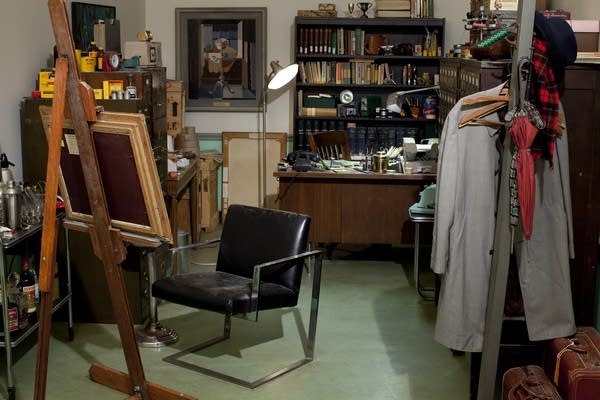MIA's 'Truthiness' exhibit examines blurry lines of fact and fiction

On April Fools' Day, people often view the news with a certain amount of skepticism.
"More Real? Art in the Age of Truthiness," a new exhibit at the Minneapolis Institute of Arts, suggests that in today's media-saturated world, perhaps every day is April Fools' - and people should always question the validity of what they see and hear.
It's not often that patrons are welcomed to a museum exhibition by a comedian, but at the MIA's show, Stephen Colbert sets the tone for what's to come.
In a video clip, he says: "Anybody who knows me knows that I'm no fan of dictionaries or reference books -- they're elitist, constantly telling us what is or isn't true, or what did or didn't happen."
Create a More Connected Minnesota
MPR News is your trusted resource for the news you need. With your support, MPR News brings accessible, courageous journalism and authentic conversation to everyone - free of paywalls and barriers. Your gift makes a difference.
"More Real" presents works of art that demand viewers pay attention. An elevator appears stuck in the middle of a gallery floor; a door welcomes visitors into a curator's office supposedly sealed off decades ago.

The exhibit is inspired by the times, said curator Liz Armstrong. When people get their news from comedy shows and CNN reporters are hired to write fiction, who knows what is real anymore?
"Anybody can fake photographs, news, information," Armstrong said. "'Wiki-reality' is a tricky thing, and we live in it now."
The Internet, social media and smartphones provide access to more information and images than ever before, aiding revolutions in Egypt and inspiring government crackdowns in China.
Amid all this social and political upheaval, Armstrong said it's more critical than ever to remember that seeing is not necessarily believing.
On a recent afternoon, Chadwick Boyer of Eau Claire, Wis., toured "More Real" and found himself caught up in a piece called "No Fun." It documents the reactions of people who logged on to the site Chatroulette, only to find themselves linked by video with someone who had apparently hanged himself in his apartment. The viewer comments were mostly disaffected, sometimes hateful; only one actually bothered to call the authorities in case the suicide was real.

"It makes me think of Facebook and how everyone will say what's on their mind regardless of whether or not it's polite," Boyer said. "It just seems like anything through a computer screen is not real ... so we just assume it isn't automatically."
Boyer, a former journalism student, said he thinks people should fact-check what they read or hear, even from a major newspaper.
Artist Inigo Manglano-Ovalle wishes more people had felt that way in February 2003 when Secretary of State Colin Powell testified that there were weapons of mass destruction hidden on trucks in the Iraq desert. Six weeks later the United States invaded.
Manglano-Ovalle was struck by how the evidence Powell presented, the images of the trucks, were blurry and indistinct.
"Often power and ideology use the low-resolution image -- the image that can't be contested because it's not presenting itself as a truthful photograph but as an image of what could be -- some sort of stand-in," Manglano-Ovalle said.

Powell's speech inspired the artist to build "Phantom Truck" -- based on the evidence that was available. The truck is exhibited at the MIA in a darkened room, where it's visible only after viewers' eyes have adjusted.
Manglano-Ovalle said the truck is a Trojan horse, as he believes was Powell's speech. He said the speech was the vehicle by which the war was made possible, and as a result more than 100,000 civilians died.
Upon seeing "Phantom Truck," Rona Peterson of Robbinsdale, Minn., said her thoughts immediately turned to the news media.
"How many times have I been lied to?" Peterson said. "I can't help but think that -- who's twisting my reality and why? What are they trying to achieve? And what does my little opinion have to do with all of it?"
While a comedian may have opened the show, images of war and death took their toll on Minneapolis poet Louis Alemayehu. He left the exhibition disturbed by the works he saw.
"Fragmentation, disconnection, violence, numbness, things that can easily provoke rage and grief," Alemayehu said. "We're presented with a lot of images in the media that are very violent, and I think for some of us, we have to back away from it or become numb to it and keep watching."
Alemayehu said that seeing "More Real" left him craving a return to reality - to his friendships, his community, the trees, the water and the sky.
